Paper Menu >>
Journal Menu >>
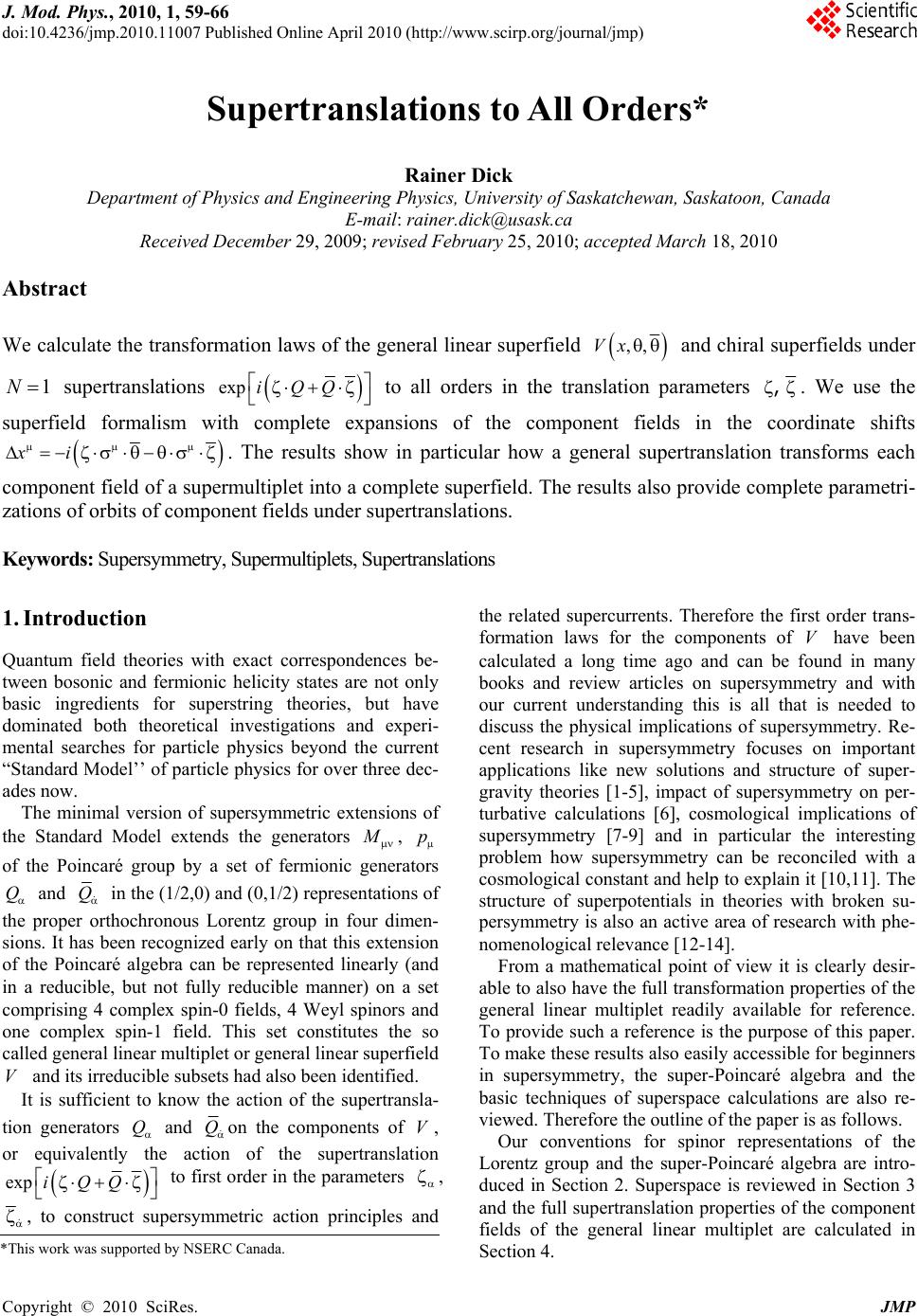 J. Mod. Phys., 2010, 1, 59-66 doi:10.4236/jmp.2010.11007 Published Online April 2010 (http://www.scirp.org/journal/jmp) Copyright © 2010 SciRes. JMP Supertranslations to All Orders* Rainer Dick Department of Physi cs a nd Engineering Phys ic s, Universi t y of Sa skat chewan, Sask ato o n, C a na d a E-mail: rainer.dick@usask.ca Received December 29, 2009; revised February 25, 2010; accepted March 18, 2010 Abstract We calculate the transformation laws of the general linear superfield ,,Vx and chiral superfields under 1N supertranslations exp iQQ to all orders in the translation parameters , . We use the superfield formalism with complete expansions of the component fields in the coordinate shifts xi . The results show in particular how a general supertranslation transforms each component field of a supermultiplet into a complete superfield. The results also provide complete parametri- zations of orbits of component fields under supertranslations. Keywords: Supersymmetry, Supermultiplets, Supertranslations 1. Introduction Quantum field theories with exact correspondences be- tween bosonic and fermionic helicity states are not only basic ingredients for superstring theories, but have dominated both theoretical investigations and experi- mental searches for particle physics beyond the current “Standard Model’’ of particle physics for over three dec- ades now. The minimal version of supersymmetric extensions of the Standard Model extends the generators M , p of the Poincaré group by a set of fermionic generators Q and Q in the (1/2,0) and (0 ,1/2) represen tations of the proper orthochronous Lorentz group in four dimen- sions. It has been recognized early on that this extension of the Poincaré algebra can be represented linearly (and in a reducible, but not fully reducible manner) on a set comprising 4 complex spin-0 fields, 4 Weyl spinors and one complex spin-1 field. This set constitutes the so called general linear multiplet or general linear superfield V and its irreducible subsets had also been identified. It is sufficient to know the action of the supertransla- tion generators Q and Q on the components of V, or equivalently the action of the supertranslation exp iQQ to first order in the parameters , , to construct supersymmetric action principles and the related supercurrents. Therefore the first order trans- formation laws for the components of V have been calculated a long time ago and can be found in many books and review articles on supersymmetry and with our current understanding this is all that is needed to discuss the physical implications of supersymmetry. Re- cent research in supersymmetry focuses on important applications like new solutions and structure of super- gravity theories [1-5], impact of supersymmetry on per- turbative calculations [6], cosmological implications of supersymmetry [7-9] and in particular the interesting problem how supersymmetry can be reconciled with a cosmological constant and help to explain it [10,11]. The structure of superpotentials in theories with broken su- persymmetry is also an active area of research with phe- nomenological relevance [12-14]. From a mathematical point of view it is clearly desir- able to also have the full tr ansformation properties of the general linear multiplet readily available for reference. To provide such a reference is the purpose of this paper. To make these results also easily accessible for beginners in supersymmetry, the super-Poincaré algebra and the basic techniques of superspace calculations are also re- viewed. Therefore the outline of the paper is as follows. Our conventions for spinor representations of the Lorentz group and the super-Poincaré algebra are intro- duced in Section 2. Superspace is reviewed in Section 3 and the full supertrans lation properties of the component fields of the general linear multiplet are calculated in Section 4. *This work was supported by NSERC Canada.  R. DIC K Copyright © 2010 SciRes. JMP 60 Chiral superfields provide a particular irreducible re- presentation within the reducible linear multiplet. Due to their practical relevance for the supersymmetrization of matter fields, the resulting supertranslation properties of the components of chiral superfields are listed in Section 5. Appendix 1 contains a translation of our results into the conventions of Wess and Bagger [15]. The relevant spinor indices are reviewed in Appendix 2. Our conventions for spinor representations and super- space calculations differ from Wess and Bagger only with regard to the definition of superderivatives and the definition of the 2nd order epsilon spinors with lower indices. Sections 2 and 3 are included to make the paper self-contained and easily accessible and to clarify con- ventions. However, the new results in Sections 4 and 5 are not affected by the different definitions. The cogno- scenti should therefore go straight to Section 4. 2. The Super-Poincaré Algebra The basic methodology for calculations with linear su- per-multiplets in four dimensions was developed some 35 years ago by Wess, Zumino, Salam, Strathdee and Ferrara [16-19]. This section and the following section provide a brief but concise introduction to the calcula- tional techniques of supersymmetry and its linear repre- sentations in four dimensions. We use 001 for the Minkowski metric and standard notation with 00 11 22 33 10 01 ,, 01 10 010 , 101 i i for the Pauli matrices. Complex conjugation turns undotted indices into dot- ted indices and vice versa, , a and hermiticity of the Pauli matrices implies for the complex conjugate matrices . (1) We pull spinor indices with the two-dimensional epsi- lon spinors 12 12 12 12 1, 1, ,, ,. (2) The Equations (1) then imply that the conjugate Pauli matrices with upper spinor indices are . (3) Numerically, we have with the upper index positions for the barred matrices and lower index positions for the unbarred matrices 00 ,. ii Although not formally required, use of upper indices for barred Pauli matrices and lower indices for un- barredPauli matrices is a useful and very common con- vention. Relations for Pauli matrices are meticulously compiled in [15]. For convenience, we recall those relations which are directly relevant for the derivation of supertransla- tions to all orders, 2, (4) 2, (5) 2, (6) 2,Tr (7) and 0123 .i (8) The factor 01231 was included to allow for ready use of both conventions for the four-dimensional epsilon tensor. We will briefly recall below that pulling spinor indices with the 2nd order epsilon spinors is motivated by the fact that this yields Lorentz invariant spinor products , (9) where the anti-commutation property of spinors was used. Conjugation also implies re-ordering of spinor quantities, such that conjugation of (9) yields . (10) The vector representation matrices of the Lorentz al- gebra, ,L appear as structure constants in the Poincaré algebra. The spinor representations of a proper orthochronous Lorentz transformation 1 exp exp 22 i M L are given by exp 2 i US and exp , 2 i US with generators , 4 . 4 i S i S 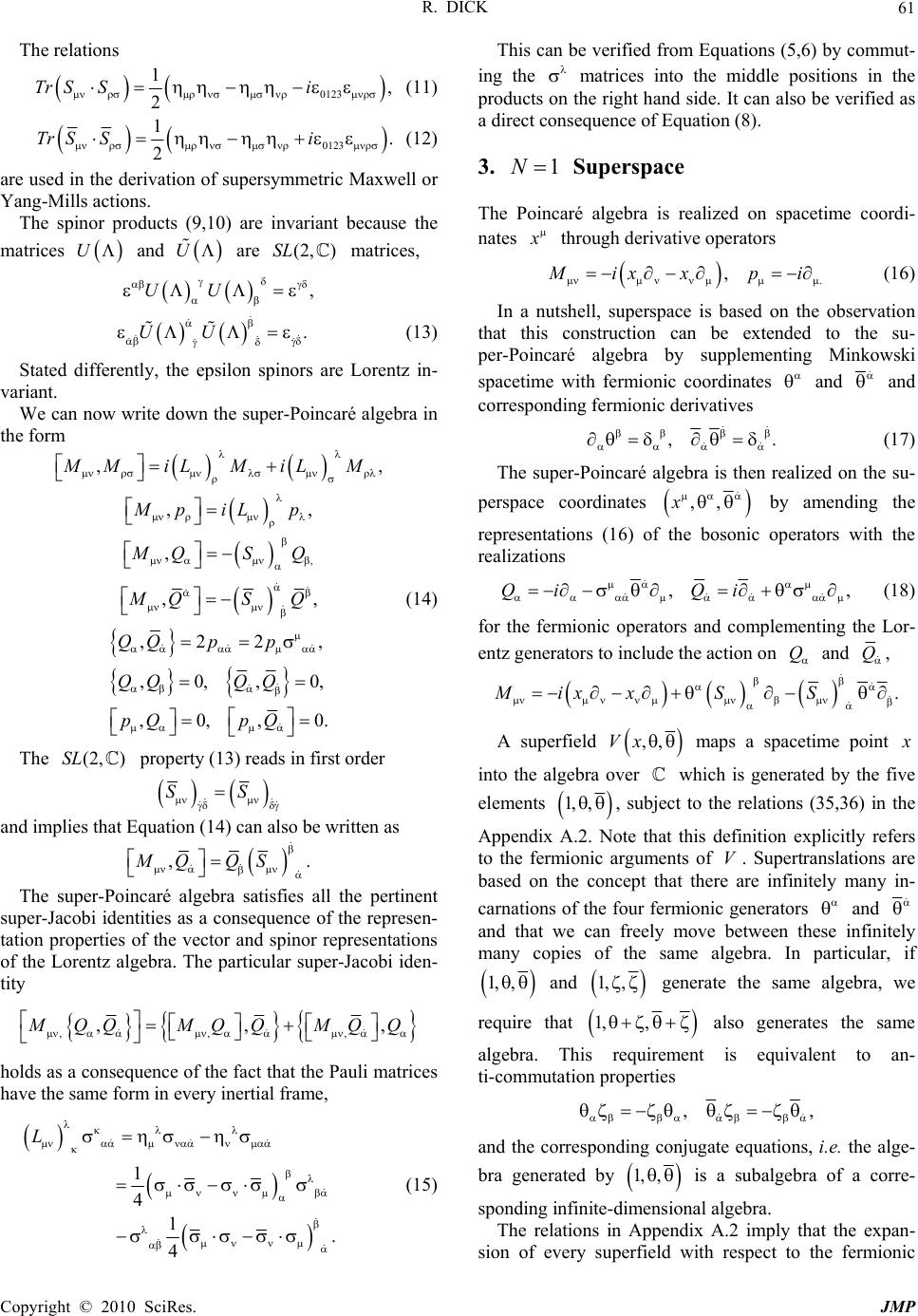 R. DICK Copyright © 2010 SciRes. JMP 61 The relations 0123 1, 2 Tr SSi (11) 0123 1. 2 Tr SSi (12) are used in the deriv ation of supersymmetric Maxwell or Yang-Mills actions. The spinor products (9,10) are invariant because the matrices U and U are (2, )SL matrices, ,UU .UU (13) Stated differently, the epsilon spinors are Lorentz in- variant. We can now write down the sup er-Poincaré algebra in the form ,,MMiLMiLM ,, M piL p , , M QSQ ,, M QSQ (14) ,22, ,0,,0, ,0,,0. QQ p p QQ QQ pQ pQ The (2, )SL property (13) reads in first order SS and implies that Equation (14) can also be written as ,.MQ QS The super-Poincaré algebra satisfies all the pertinent super-Jacobi identities as a consequence of the represen- tation properties of the vector and spinor representations of the Lorentz algebra. The particular super-Jacobi iden- tity ,,, ,,, M QQMQQMQ Q holds as a consequence of the fact that the Pauli matrices have the same form in every inertial frame, 1 41. 4 L (15) This can be verified from Equations (5,6) by commut- ing the matrices into the middle positions in the products on the right hand side. It can also be verified as a direct consequence of Equation (8). 3. 1N Superspace The Poincaré algebra is realized on spacetime coordi- nates x through derivative operators . , M ixxp i (16) In a nutshell, superspace is based on the observation that this construction can be extended to the su- per-Poincaré algebra by supplementing Minkowski spacetime with fermionic coordinates and and correspondin g fermionic derivat i ves ,. (17) The super-Poincaré algebra is then realized on the su- perspace coordinates ,,x by amending the representations (16) of the bosonic operators with the realizations ,,Qi Qi (18) for the fermionic operators and complementing the Lor- entz generators to include the action on Q and Q , .Mixx SS A superfield ,,Vx maps a spacetime point x into the algebra over which is generated by the five elements 1, , , subject to the relations (35,36) in the Appendix A.2. Note that this definition explicitly refers to the fermionic arguments of V. Supertranslations are based on the concept that there are infinitely many in- carnations of the four fermionic generators and and that we can freely move between these infinitely many copies of the same algebra. In particular, if 1, , and 1, , generate the same algebra, we require that 1, , also generates the same algebra. This requirement is equivalent to an- ti-commutation properties ,, and the corresponding conjugate equations, i.e. the alge- bra generated by 1, , is a subalgebra of a corre- sponding infinite-dimensional algebra. The relations in Appendix A.2 imply that the expan- sion of every superfield with respect to the fermionic 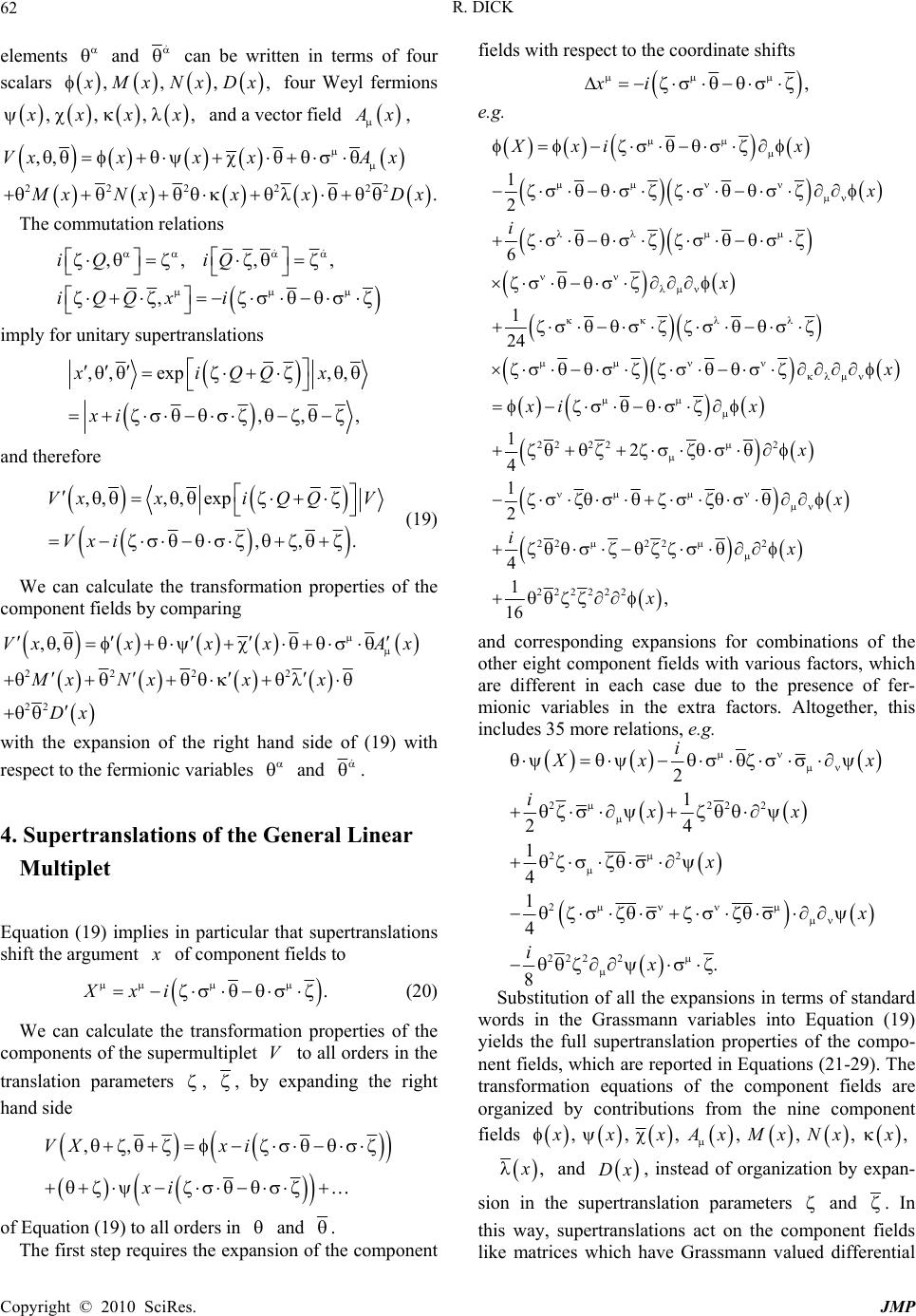 R. DICK Copyright © 2010 SciRes. JMP 62 elements and can be written in terms of four scalars ,,,, x Mx Nx Dx four Weyl fermions ,,,, x xxx and a vector field A x , 222 222 ,, . VxxxxA x M xNxxxDx The commutation relations ,,,, , iQ iQ iQQx i imply for unitary supertranslations ,, exp,, ,, , xiQQx xi and therefore ,,,, exp ,,. Vxxi QQV Vxi (19) We can calculate the transformation properties of the component fields by comparing 222 2 22 ,,Vxxx xAx Mx Nxxx Dx with the expansion of the right hand side of (19) with respect to the fermionic variables and . 4. Supertranslations of the General Linear Multiplet Equation (19) implies in particular that supertranslations shift the argument x of component fields to .Xxi (20) We can calculate the transformation properties of the components of the supermultiplet V to all ord ers in the translation parameters , , by expanding the right hand side ,,VX xi xi of Equation (19) to all orders in and . The first step requires the expansion of the component fields with respect to the coordinate shifts ,xi e.g. 1 2 6 1 24 Xxi x x i x x xi x 22 222 22 222 222222 12 4 1 2 4 1, 16 x x ix x and corresponding expansions for combinations of the other eight component fields with various factors, which are different in each case due to the presence of fer- mionic variables in the extra factors. Altogether, this includes 35 more relations, e.g. 2222 22 2 2222 21 24 1 4 1 4 . 8 i X xx ixx x x ix Substitution of all the expansions in terms of standard words in the Grassmann variables into Equation (19) yields the full supertranslation properties of the compo- nent fields, which are reported in Equations (21-29). The transformation equations of the component fields are organized by contributions from the nine component fields , x , x , x , A x , M x ,Nx , x , x and Dx, instead of organization by expan- sion in the supertranslation parameters and . In this way, supertranslations act on the component fields like matrices which have Grassmann valued differential 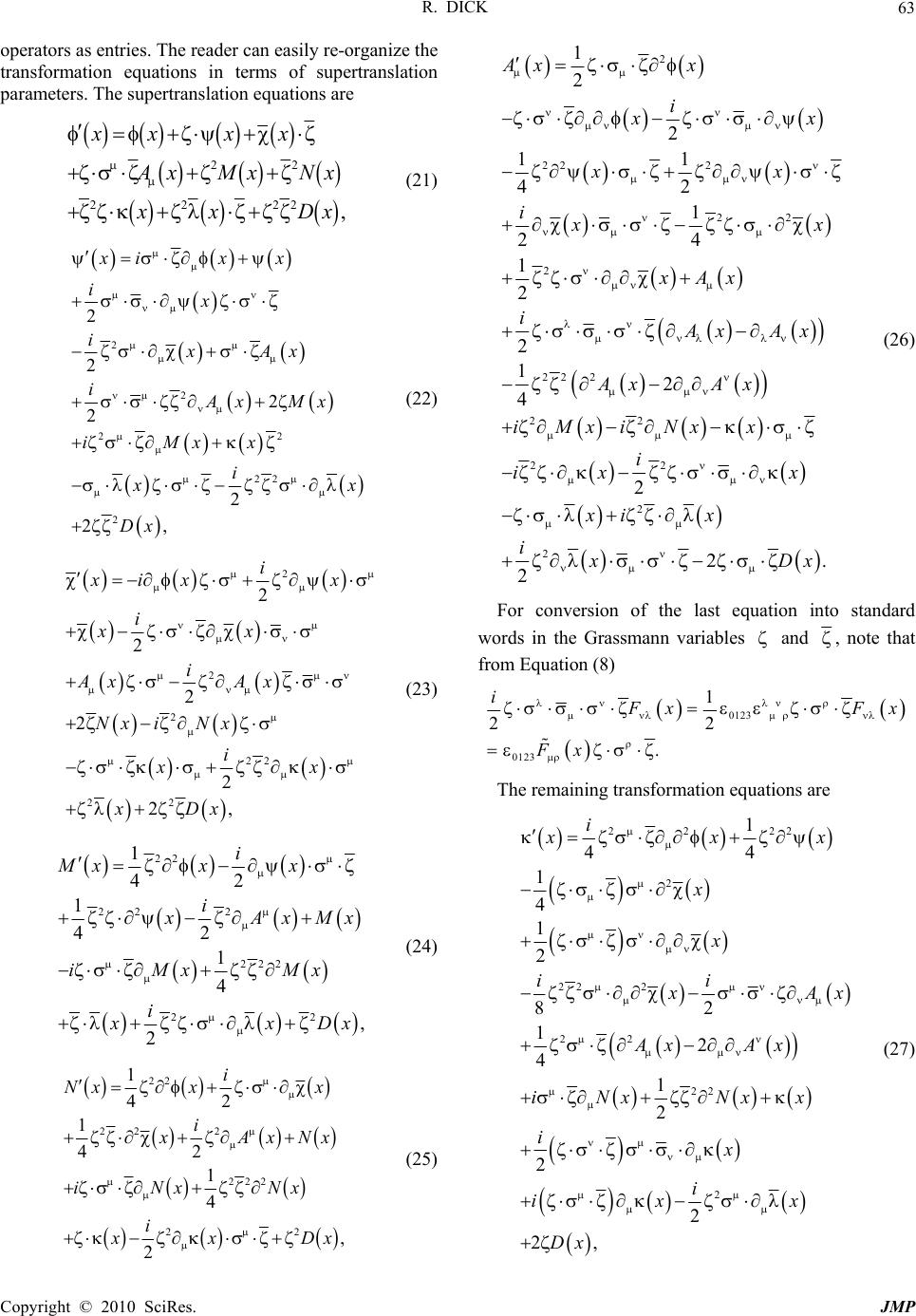 R. DICK Copyright © 2010 SciRes. JMP 63 operators as entries. The reader can easily re-organize the transformation equations in terms of supertranslation parameters. The supertranslation equations are 22 2222 , xx xx A xMxNx x xDx (21) 2 2 22 22 2 2 2 2 2 2 2, xix x ix ixAx iAx Mx iMxx i x x Dx (22) 2 2 2 22 22 2 2 2 2 2 2, i xix x i xx i Ax Ax Nx iNx i xx xDx (23) 22 22 2 222 22 1 42 1 42 1 4 , 2 i Mxx x i x Ax Mx iMx Mx i x xDx (24) 22 22 2 222 22 1 42 1 42 1 4 , 2 i Nx xx i x Ax Nx iNx Nx i x xDx (25) 2 222 22 2 22 2 22 2 1 2 2 11 42 1 24 1 2 2 12 4 Ax x i x x xx i x x xAx iAx Ax Ax Ax iMxiNx x i 2 2 2 2 2. 2 i xx xi x ixDx (26) For conversion of the last equation into standard words in the Grassmann variables and , note that from Equation (8) 0123 0123 1 22 . iFx Fx Fx The remaining transformation equations are 22 22 2 22 2 22 22 2 1 44 1 4 1 2 82 12 41 2 2 2 2, i xxx x x ii x Ax Ax Ax iNx Nxx ix i ix x Dx (27) 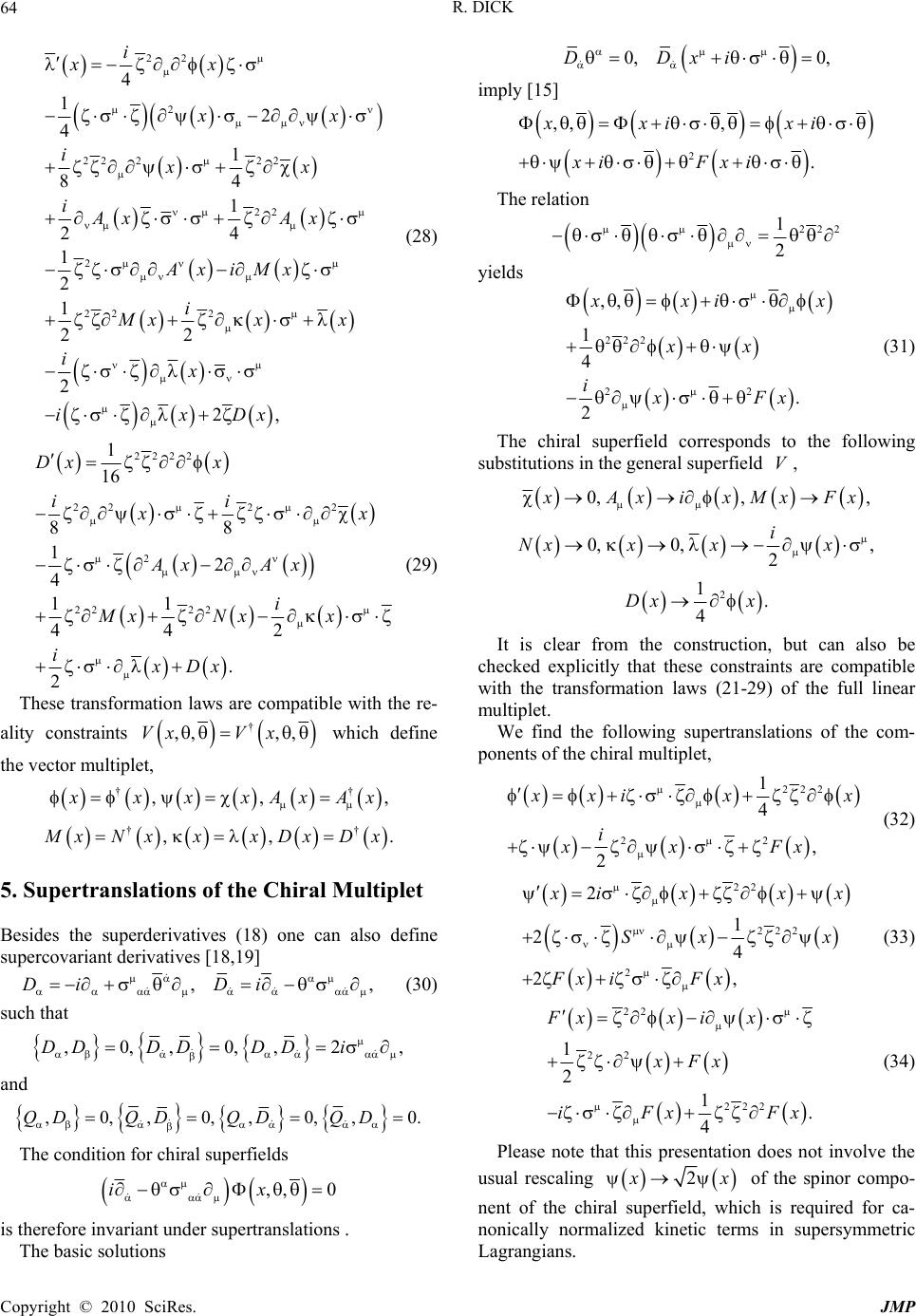 R. DICK Copyright © 2010 SciRes. JMP 64 22 2 22 222 22 2 22 2 4 12 41 84 1 24 1 2 1 22 2 2, i xx xx ixx iAx Ax Ax iMx i Mxx x ix ixDx (28) 2222 222 2 2 22 22 1 16 88 12 4 11 442 . 2 Dx x ii x x Ax Ax i Mx Nxx ixDx (29) These transformation laws are compatible with the re- ality constraints † ,, ,,VxV x which define the vector multiplet, †† ,, , x xx xAxAx †† ,, . M xNx xxDxDx 5. Supertranslations of the Chiral Mu lti ple t Besides the superderivatives (18) one can also define supercovariant de rivatives [18,19] ,,Di Di (30) such that ,0,,0,,2,DD DD DDi and , 0,, 0,,0,,0.QD QD QDQD The condition for chiral sup erfields ,, 0ix is therefore invariant under supertranslations . The basic solut i ons 0, 0,DDxi imply [15] 2 ,, , . xxi xi xi Fxi The relation 222 1 2 yields 222 22 ,, 1 4 . 2 x xi x xx ixFx (31) The chiral superfield corresponds to the following substitutions in the general superfield V, 0,, , x Ax ixMxFx 0, 0,, 2 i Nx xxx 2 1. 4 Dx x It is clear from the construction, but can also be checked explicitly that these constraints are compatible with the transformation laws (21-29) of the full linear multiplet. We find the following supertranslations of the com- ponents of the chiral multiplet, 222 22 1 4 , 2 x xi xx i xxFx (32) 22 222 2 2 1 24 2, x ix xx Sxx Fx iFx (33) 22 22 222 1 21. 4 Fxx ix xFx iFx Fx (34) Please note that this presentation does not involve the usual rescaling 2 x x of the spinor compo- nent of the chiral superfield, which is required for ca- nonically normalized kinetic terms in supersymmetric Lagrangians. 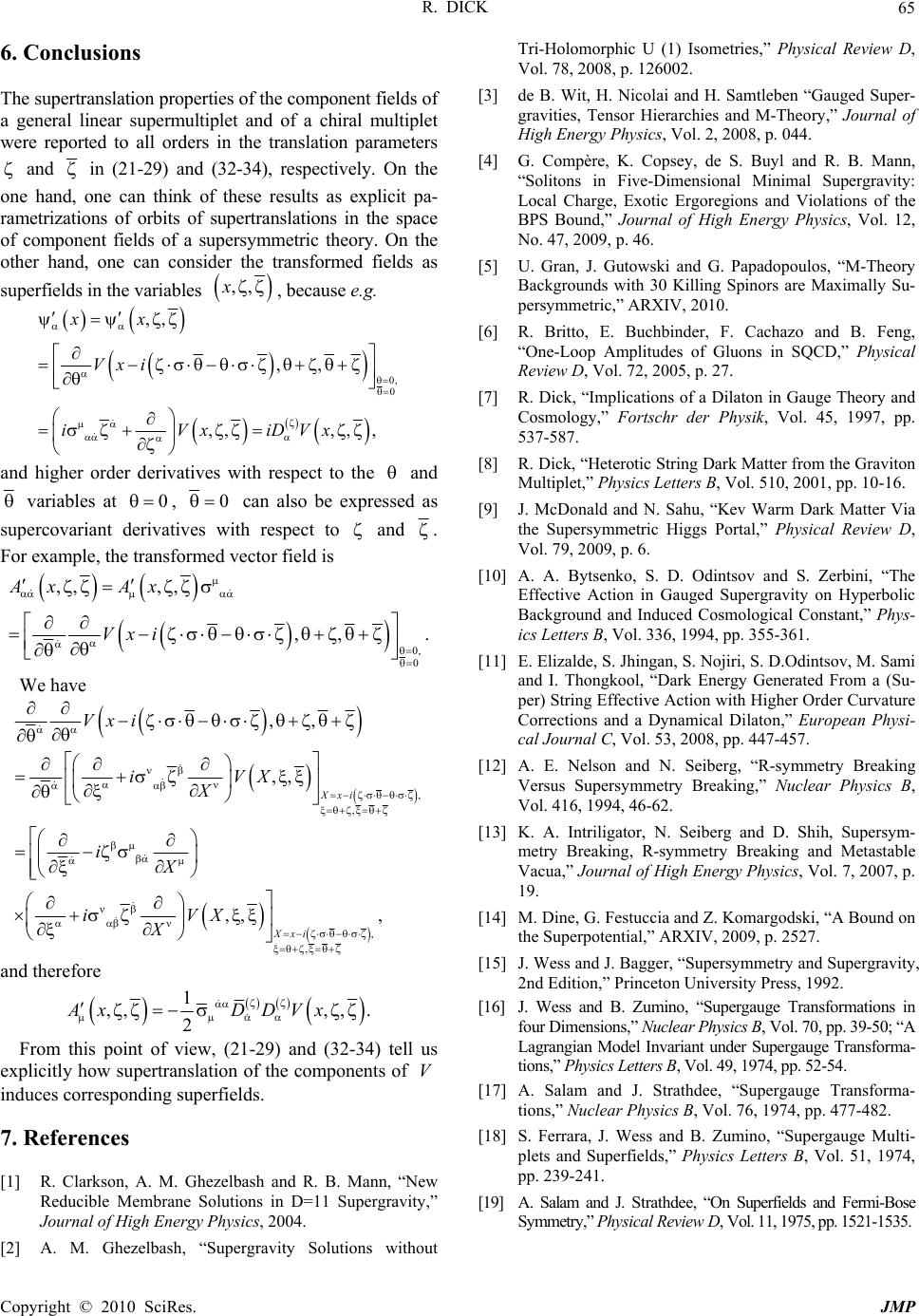 R. DICK Copyright © 2010 SciRes. JMP 65 6. Conclusions The supertranslation properties of the component fields of a general linear supermultiplet and of a chiral multiplet were reported to all orders in the translation parameters and in (21-29) and (32-34), respectively. On the one hand, one can think of these results as explicit pa- rametrizations of orbits of supertranslations in the space of component fields of a supersymmetric theory. On the other hand, one can consider the transformed fields as superfields in the variables ,,x , because e.g. 0, 0 ,, ,, ,,,, , xx Vxi iVxiDVx and higher order derivatives with respect to the and variables at 0 , 0 can also be expressed as supercovariant derivatives with respect to and . For example, the transformed vector field is 0, 0 ,, ,, ,,. Ax Ax Vx i We have , , , , ,, ,, ,, , Xxi Xxi Vxi iVX X iX iVX X and therefore 1 ,,,, . 2 Ax DDVx From this point of view, (21-29) and (32-34) tell us explicitly how supertranslation of the components of V induces corresponding superfields. 7. References [1] R. Clarkson, A. M. Ghezelbash and R. B. Mann, “New Reducible Membrane Solutions in D=11 Supergravity,” Journal of High Energy Physics, 2004. [2] A. M. Ghezelbash, “Supergravity Solutions without Tri-Holomorphic U (1) Isometries,” Physical Review D, Vol. 78, 2008, p. 126002. [3] de B. Wit, H. Nicolai and H. Samtleben “Gauged Super- gravities, Tensor Hierarchies and M-Theory,” Journal of High Energy Physics, Vol. 2, 2008, p. 044. [4] G. Compère, K. Copsey, de S. Buyl and R. B. Mann, “Solitons in Five-Dimensional Minimal Supergravity: Local Charge, Exotic Ergoregions and Violations of the BPS Bound,” Journal of High Energy Physics, Vol. 12, No. 47, 2009, p. 46. [5] U. Gran, J. Gutowski and G. Papadopoulos, “M-Theory Backgrounds with 30 Killing Spinors are Maximally Su- persymmetric,” ARXIV, 2010. [6] R. Britto, E. Buchbinder, F. Cachazo and B. Feng, “One-Loop Amplitudes of Gluons in SQCD,” Physical Review D, Vol. 72, 2005, p. 27. [7] R. Dick, “Implications of a Dilaton in Gauge Theory and Cosmology,” Fortschr der Physik, Vol. 45, 1997, pp. 537-587. [8] R. Dick, “Heterotic String Dark Matter from the Graviton Multiplet,” Physics Letters B, Vol. 510, 2001, pp. 10-16. [9] J. McDonald and N. Sahu, “Kev Warm Dark Matter Via the Supersymmetric Higgs Portal,” Physical Review D, Vol. 79, 2009, p. 6. [10] A. A. Bytsenko, S. D. Odintsov and S. Zerbini, “The Effective Action in Gauged Supergravity on Hyperbolic Background and Induced Cosmological Constant,” Phys- ics Letters B, Vol. 336, 1994, pp. 355-361. [11] E. Elizalde, S. Jhingan, S. Nojiri, S. D.Odintsov, M. Sami and I. Thongkool, “Dark Energy Generated From a (Su- per) String Effective Action with Higher Order Curvature Corrections and a Dynamical Dilaton,” European Physi- cal Journal C, Vol. 53, 2008, pp. 447-457. [12] A. E. Nelson and N. Seiberg, “R-symmetry Breaking Versus Supersymmetry Breaking,” Nuclear Physics B, Vol. 416, 1994, 46-62. [13] K. A. Intriligator, N. Seiberg and D. Shih, Supersym- metry Breaking, R-symmetry Breaking and Metastable Vacua,” Journal of High Energy Physics, Vol. 7, 2007, p. 19. [14] M. Dine, G. Festuccia and Z. Komargodski, “A Bound on the Superpotential,” ARXIV, 2009, p. 2527. [15] J. Wess and J. Bagger, “Supersymmetry and Supergravity, 2nd Edition,” Princeton University Press, 1992. [16] J. Wess and B. Zumino, “Supergauge Transformations in four Dimensio ns,” Nu clear Ph ysic s B, Vol. 70, pp. 39-50; “A Lagrangian Model Invariant under Supergauge Transforma- tions,” Phys ics Le tters B, Vol. 49, 1974, pp. 52-54. [17] A. Salam and J. Strathdee, “Supergauge Transforma- tions,” Nuclear Physics B, Vol. 76, 1974, pp. 477-482. [18] S. Ferrara, J. Wess and B. Zumino, “Supergauge Multi- plets and Superfields,” Physics Letters B, Vol. 51, 1974, pp. 239-241. [19] A. Salam and J. Strathdee, “On Superfields and Fermi-Bose Symmetry,” Physical Review D, Vol. 11, 1975, pp. 1521-1535. 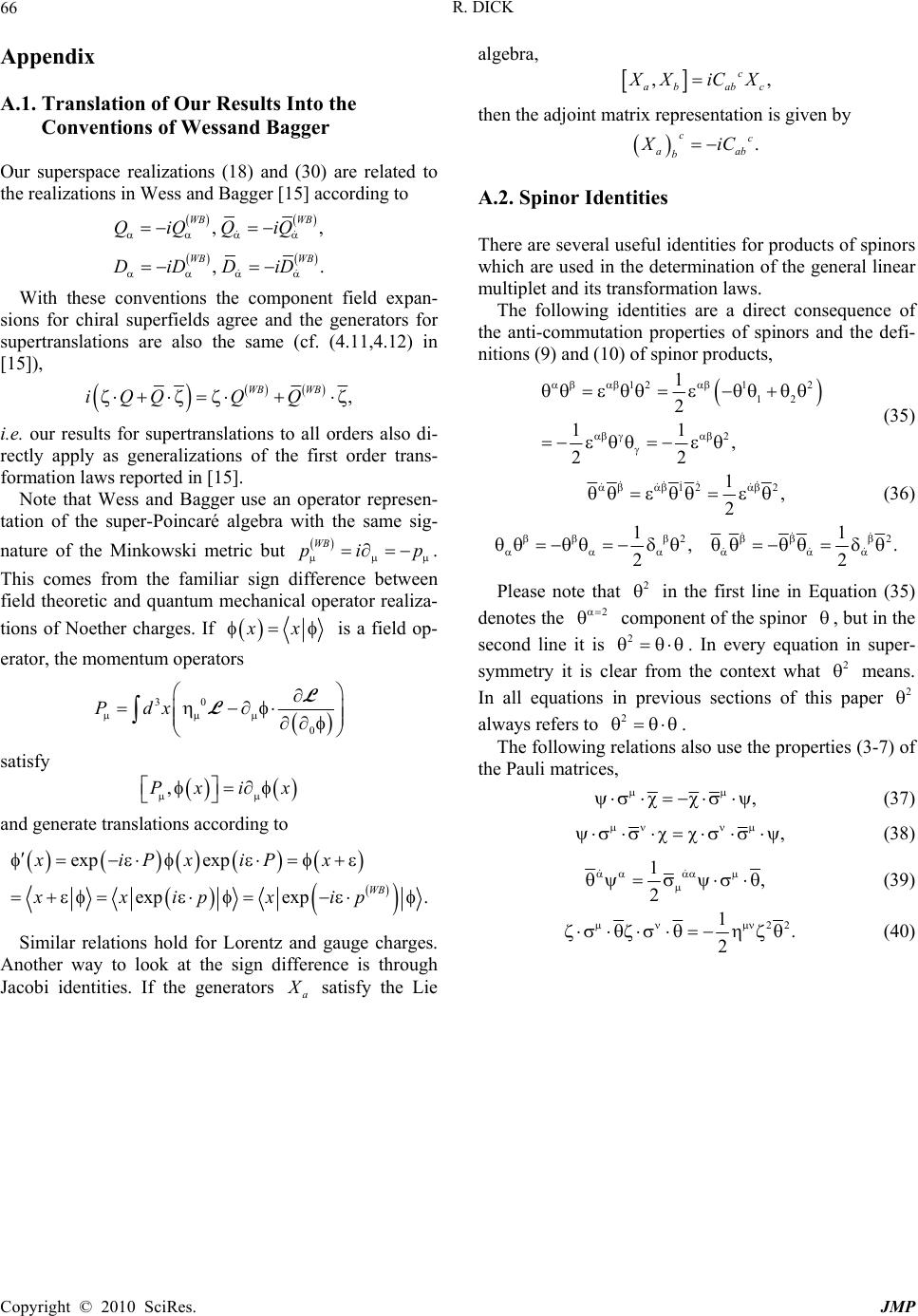 R. DICK Copyright © 2010 SciRes. JMP 66 Appendix A.1. Translation of Our Results Into the Conventions of Wessand Bagger Our superspace realizations (18) and (30) are related to the realizations in Wess and Bagger [15] according to ,, WB WB QiQQiQ ,. WB WB DiDDiD With these conventions the component field expan- sions for chiral superfields agree and the generators for supertranslations are also the same (cf. (4.11,4.12) in [15]), , WB WB iQQQQ i.e. our results for supertranslations to all orders also di- rectly apply as generalizations of the first order trans- formation laws reported in [15]. Note that Wess and Bagger use an operator represen- tation of the super-Poincaré algebra with the same sig- nature of the Minkowski metric but WB pip . This comes from the familiar sign difference between field theoretic and quantum mechanical operator realiza- tions of Noether charges. If x x is a field op- erator, the momentum operators 30 0 Pdx L L satisfy ,Pxi x and generate translations according to exp exp expexp . WB xiPxiPx xxipxip Similar relations hold for Lorentz and gauge charges. Another way to look at the sign difference is through Jacobi identities. If the generators a X satisfy the Lie algebra, ,, c ab abc X XiCX then the adjoint matrix representation is given by . cc aab b XiC A.2. Spinor Identities There are several useful identities for products o f spinors which are used in the determination of the general linear multiplet and its transformation laws. The following identities are a direct consequence of the anti-commutation properties of spinors and the defi- nitions (9) and (10) of spinor products, 121 2 12 2 1 2 11 , 22 (35) 12 2 1, 2 (36) 22 11 ,. 22 Please note that 2 in the first line in Equation (35) denotes the 2 component of the spinor , but in the second line it is 2 . In every equation in super- symmetry it is clear from the context what 2 means. In all equations in previous sections of this paper 2 always refers to 2 . The following relations also use the prop erties (3-7) of the Pauli matrices, , (37) , (38) 1, 2 (39) 22 1. 2 (40) |

